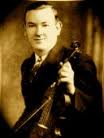Annotation:Memories of Ballymote: Difference between revisions
No edit summary |
m (Text replacement - "garamond, serif" to "sans-serif") |
||
| Line 1: | Line 1: | ||
=='''Back to [[{{BASEPAGENAME}}]]'''== | =='''Back to [[{{BASEPAGENAME}}]]'''== | ||
---- | ---- | ||
<p><font face=" | <p><font face="sans-serif" size="4"> | ||
'''MEMORIES OF BALLYMOTE.''' AKA and see "[[Church Street Polka (2)]]." Irish, Polka. G Major. Standard tuning (fiddle). AABB'. A polka in the Sligo/Leitrim tradition (as opposed to the Kerry polka tradition), played at a rather relaxed pace (when compared with the southern polka tradition). The tune was first recorded in New York by fiddler Paddy Killoran [http://en.wikipedia.org/wiki/Paddy_Killoran] (1904-1965), himself originally Ballymote, south County Sligo, for Decca records in 1937 (Decca 12103, backed by Jim McGinn on piano). "Memories of Ballymote" is usually known nowadays under the "Church Street" title today, stemming from the influential recording by the Chieftains in 1964. | '''MEMORIES OF BALLYMOTE.''' AKA and see "[[Church Street Polka (2)]]." Irish, Polka. G Major. Standard tuning (fiddle). AABB'. A polka in the Sligo/Leitrim tradition (as opposed to the Kerry polka tradition), played at a rather relaxed pace (when compared with the southern polka tradition). The tune was first recorded in New York by fiddler Paddy Killoran [http://en.wikipedia.org/wiki/Paddy_Killoran] (1904-1965), himself originally Ballymote, south County Sligo, for Decca records in 1937 (Decca 12103, backed by Jim McGinn on piano). "Memories of Ballymote" is usually known nowadays under the "Church Street" title today, stemming from the influential recording by the Chieftains in 1964. | ||
[[File:killoran.jpg|200px|thumb|left|Paddy Killoran]] | [[File:killoran.jpg|200px|thumb|left|Paddy Killoran]] | ||
| Line 7: | Line 7: | ||
<br> | <br> | ||
</font></p> | </font></p> | ||
<p><font face=" | <p><font face="sans-serif" size="4"> | ||
''Source for notated version'': | ''Source for notated version'': | ||
<br> | <br> | ||
<br> | <br> | ||
</font></p> | </font></p> | ||
<p><font face=" | <p><font face="sans-serif" size="4"> | ||
''Printed sources'': | ''Printed sources'': | ||
<br> | <br> | ||
<br> | <br> | ||
</font></p> | </font></p> | ||
<p><font face=" | <p><font face="sans-serif" size="4"> | ||
''Recorded sources'': <font color=teal>Decca 12103 (78 RPM), Paddy Killoran (1937). Ben Lennon & Friends - "The Natural Bridge." </font> | ''Recorded sources'': <font color=teal>Decca 12103 (78 RPM), Paddy Killoran (1937). Ben Lennon & Friends - "The Natural Bridge." </font> | ||
<br> | <br> | ||
<br> | <br> | ||
</font></p> | </font></p> | ||
<p><font face=" | <p><font face="sans-serif" size="4"> | ||
See also listing at:<br> | See also listing at:<br> | ||
Alan Ng's Irishtune.info [http://www.irishtune.info/tune/2451/]<br> | Alan Ng's Irishtune.info [http://www.irishtune.info/tune/2451/]<br> | ||
Revision as of 14:20, 6 May 2019
Back to Memories of Ballymote
MEMORIES OF BALLYMOTE. AKA and see "Church Street Polka (2)." Irish, Polka. G Major. Standard tuning (fiddle). AABB'. A polka in the Sligo/Leitrim tradition (as opposed to the Kerry polka tradition), played at a rather relaxed pace (when compared with the southern polka tradition). The tune was first recorded in New York by fiddler Paddy Killoran [1] (1904-1965), himself originally Ballymote, south County Sligo, for Decca records in 1937 (Decca 12103, backed by Jim McGinn on piano). "Memories of Ballymote" is usually known nowadays under the "Church Street" title today, stemming from the influential recording by the Chieftains in 1964.

Source for notated version:
Printed sources:
Recorded sources: Decca 12103 (78 RPM), Paddy Killoran (1937). Ben Lennon & Friends - "The Natural Bridge."
See also listing at:
Alan Ng's Irishtune.info [2]
Hear Killoran's 1937 recording at the Internet Archive [3] [4]
